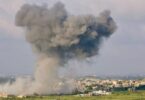Paul Tullis
Roy Slaterus has been birdwatching since he was 7 or 8, and now, at 44, he says he can recognize nearly all of the 200-plus species of birds that are endemic to his native Netherlands by their calls. On a cool May morning just north of Amsterdam, under skies such as Albert Cuyp might have painted, he identifies a black-tailed godwit flying behind him by its warning sound. “He’s showing off nicely,” Slaterus says of the godwit, his country’s national bird, “saying to us that it has chicks and doesn’t want us around.”
Slaterus is an environmental planner by training and a researcher with Sovon Bird Research Netherlands, a nonprofit that monitors bird populations in the country for management and policy development. He had set out at dawn to walk through one of many set areas, counting breeding birds on a tablet computer loaded with custom-built software with which he records every sighting of each species seen. Birds move around a lot, so to avoid counting migrants or itinerants along with the breeders, for this project he or a colleague will walk each zone six times during the spring months, including once at night. Then they use their gathered observations to determine the number of territories for all the breeding species.
“Bird-watching is still a thing that nerds do,” he says. “Always people make jokes about it, but that’s not my problem.”
Stepping out of his car, across the street from a row of houses, he dons a bright green vest identifying him to owners of any property on which he might trespass—“I count birds for research,” it reads in Dutch—then straps his binoculars around his neck and crosses through a gate into fields bordering pastureland but owned by a nonprofit that acquires land in the Netherlands to conserve it for nature. The nonprofit’s territory holds a considerably wider variety of grasses and wildflowers than the monoculture pasture on the other side of the fence, and the grass is varied enough to suit ground-nesting birds like the godwit.
Slaterus points out a Eurasian tree sparrow in the grass. “That’s not the normal house sparrow you see in Amsterdam,” he makes sure to elucidate. Next come two families of graylag goose with nearly fully-grown chicks. Later, an exciting find: “Meadow pipits! I thought maybe they were missing here, but I don’t think so.”
About an hour into his stroll, though, Slaterus encounters something he would rather not. “Oh, I see a sick barnacle goose,” he exclaims.
The species, distinctive for its black neck, white face, and striped back, summers mostly in the Arctic, but winters and breeds in northwestern Europe. Here, several families had built nests in the tall grass. (Fun fact: Since geese carry material on their bodies that is well known for its insulating properties, they often construct nests from nothing but their own down; in all his years of birdwatching and bird-counting, Slaterus has never seen a goose carrying a stick or other nesting appurtenance.)
The apparently sick bird is congregating with the families, probably for security. “When they’re sick, there comes a moment they can’t keep up with the flock anymore,” Slaterus says, so while the other singles have set out for the Russian Arctic, the ill one has lagged behind. It is unsteady on its feet and holds its head and chest in a strange way. Then it falls over on its side.
These neurological symptoms are consistent with highly pathogenic avian influenza (HPAI), and though it is late in the season for the virus to be circulating, Slaterus and his colleagues have noticed a disturbing number of sick and dead birds during their counts this year (and last year, too). “With the experience of the last months, I would take a bet” that the oddly behaving barnacle goose is so afflicted, Slaterus says. In that time, “We’ve seen things we’ve never seen before.”
Avian flu can cause neurological symptoms in birds, such as the loss of balance this barnacle goose in the Netherlands displayed in May. Photos by Roy Slaterus
HPAI used to be a disease that almost exclusively affected poultry, but in 2004 it spread to wild birds in China. Like humans who unwittingly carried SARS-CoV-2 on airplanes from Wuhan to Seattle and from Wuhan and Italy to Belgium and soon from virtually everywhere else to virtually everywhere else in early 2020, infected wild birds are often asymptomatic, so they can migrate carrying the virus. By 2005 it was in Europe. Wild birds stop over or winter in watery areas (which describes most of the Netherlands), gathering in large numbers. “That enables amplification and spillover to other species,” says Arjan Stegeman, a research veterinarian and professor of farm animal health at Utrecht University.
Between October 2021 and late September 2022, the UN’s Food and Agriculture Organization counted 9,604 HPAI “events” (including outbreaks, cases, and other disease detections) on four continents, the most ever. In December, for the first time, HPAI crossed from Europe to North America. A virus brought from across the Bering Strait led to the worst bird flu outbreak ever in the US in 2015; this season’s, begun with the introduction in Newfoundland, is approaching 2015’s in severity. In June, HPAI was detected in the Arctic for the first time, on an archipelago about halfway between Norway and the North Pole, exposing new and vulnerable species to the disease who can now bring it to their breeding grounds and spread it to yet more species and populations.
Die-offs of vulnerable species are now alarming ecologists around the world: They have hit great skuas in Scotland, which hosts 60 percent of that species’ breeding population; more than one-sixth of the wintering population of cranes in Israel; and 20 percent of the flyway population of barnacle geese. Hundreds of dead cormorants washed up on beaches in Massachusetts in June, and in July, the virus was rampant in the United Kingdom’s Farne Islands, an important breeding site for 200,000 birds across 23 species, including puffins, each summer, according to The Guardian. An entire colony of thousands of sandwich terns died in the Netherlands. In previous outbreaks, HPAI had died out by the time the terns arrived in summer, but this year’s virus hung around long enough to put them at risk, too. Since it’s novel to the species, like SARS-CoV-2 was to humans in 2020, they’re particularly vulnerable. “This population has no immunity, because they’ve never encountered it before,” says Nancy Beerens, head of the national reference laboratory for avian flu at Wageningen Bioveterinary Research in the Netherlands.
With such broad distribution this year, there is now a very real concern that the spread of a virus that originated with human activity—mass poultry farming—is now coming around to bite humans back.
Transcontinental spread allows viruses to circulate in larger avian metapopulations. That provides the pathogens’ genetic material, RNA, more opportunities to reassort and mutate, becoming perhaps more fit for sickening different species of birds or mammals. Another risk multiplier is the greater variety of HPAI than in years past. “This year is special because there are so many different genotypes involved, both viruses that have remained in Europe since last year and several new introductions from the east,” says Thijs Kuiken, a professor of comparative pathology in the department of viroscience at Erasmus Medical Centre in Rotterdam. “That is very different from all other HPAI outbreaks, which start on a single poultry farm and spread from there.”
Climate change is exacerbating the situation. Birds today migrate farther north, so when autumn comes, they sometimes go south down a different longitudinal line—which converge the closer they come to the pole—than the one they followed up in the spring.
While there have been a couple of thousand instances worldwide of people getting sick from the HPAI varieties now circulating, through contact with poultry or domesticated birds, so far these are not capable of community transmission among humans. But human flu viruses do have that capability. As HPAI reassorts and mutates in various wild bird species, their constituents deposit novel viral RNA through their droppings into poultry farms. (In birds, flu is a gastrointestinal as well as a respiratory disease.) These reservoirs of virus hosts are in contact with humans and their flu viruses. While the receptors that avian flu viruses latch onto are in a different position in the respiratory tract than in humans, hindering infection, research conducted at Erasmus Medical Centre in 2012 showed that it takes just five steps for a common HPAI to develop the capability—“gain of function,” in the field’s parlance—of making a mammal sick, and of passing the novel virus to another of its species. The potential for weaponizing this research, intended to develop better understanding of the risk HPAI presents to humans, so alarmed a number of other scientists that they called for publication to be halted; in the end, the US National Science Advisory Board for Biosecurity allowed redacted versions to be published, without “methodological and other details that could enable replication of the experiments by those who would seek to do harm.”
“From the human perspective, it could be that it’s worse if you have more reassortment, because this makes it a completely different makeup of the virus,” Stegeman says.
The influenza virus that swept the globe in 1918-1919, infecting one-third of humanity and killing more than 2 percent, was avian in origin. In 2009, a novel variety of the flu virus H1N1 infected as many as 1.4 billion people (almost two-and-a-half times as many as SARS-CoV-2); its vanishingly low death rate saved us. But H7N9, another avian flu, has killed 39 percent of the 600-plus people it infected; fortunately, it doesn’t pass person-to-person. Last year, in Russia, a virus that struck the Netherlands in 2020-21 and again in 2021-22, H5N8, infected humans for the first time. The WHO calls the risk of human-to-human transmission of H5N8 at this point “low,” but Russia’s public health minister, Anna Popova, told a press conference, “Time will tell how soon subsequent mutations will allow it to cross this barrier as well.”
Video Player
Wild birds can migrate while carrying the virus and stop or winter in watery areas, which enables amplification and spillover opportunities.
Flu viruses are categorized according to their two surface proteins, hemagglutinin (H) and neuraminidase (N). There are 18 subtypes of H and 11 of N, hence H1N1, H5N8, etc. When a cell becomes infected with, say, H1N1 and H5N8 at the same time, there’s a chance of reassortment of the proteins occurring such that an H1N8 or H5N1 subtype develops. This new subtype could have new properties for infection that might include the ability to sicken different species—the 2021-2022 flu season afflicted a different set of species than those that became sick during 2020-21.
Spread usually occurs through water, but on chicken farms, the birds are typically kept so closely together that the virus can spread between them directly. The Netherlands is the world’s top exporter of eggs and third largest of chicken meat—from a nation one-quarter the size of Alabama, making it home to some of the planet’s most intensive poultry farming. The country hosts six times the number of poultry birds per acre as the European Union average—18 times, in one province—producing 10 billion eggs and 1 million tonnes of meat a year from just 2,000 farms. By one count, about 120 farms keep 120,000 chickens each, and 34 have more than 220,000.
As the virus spreads into each new host, it replicates, and as it replicates, it mutates. Like reassortment, mutation can drive cross-species transmission because when genes copy themselves, they sometimes make mistakes. Mutations are necessary to make a virus deadly. So the more replication, the more opportunities for such errors—one of which could produce a virus with the combination of RNA that sickens humans and passes between them.
“The more viruses are circulating, the more contact,” says Beerens. “You need these mutations, but the more transmissions there are, the more potential for transmission to humans, the more risk there is.”
China and the United States host plenty of intensive poultry farming, but between 1959 and 2015, the most mutations of mild avian flu virus into a subtype deadly to birds occurred in Europe. Outbreaks of HPAI on Netherlands poultry farms this year are the worst since the European Food Safety Authority started tracking outbreaks in 2016, requiring culls of approximately 3,973,097 birds on about 66 farms in the attempt to limit further spread. EFSA reported in December that because of “the continuous risk … that these viruses may adapt further to mammals … the high level of reassorted viruses currently circulating in Europe are of concern for public health.”
With more types of HxNy virus circulating in birds, greater numbers of species involved in their spread, and more replication and hence mutation on poultry farms, there are more opportunities for a virus to develop into a novel pathogen capable of community transmission. The novel pathogen SARS-CoV-2, which causes the disease COVID-19, has so far killed more than six million people worldwide, caused a global recession, roiled stock markets, killed caregivers of more than 140,000 children in the United States alone, stunted the education of untold millions more, and caused physical and mental health traumas whose effects won’t be known for years to come.
The high density of Netherlands’ poultry farms means they present the chance of “development of HPAI variants with pandemic potential,” Kuiken says. Risk can be defined as the chance that something will happen multiplied by the consequences if it does. So even if the likelihood is small, with such possible ramifications, the risk is nonetheless very high.
Made with Flourish
“You get overwhelmed when you see these sick birds.”
Ten minutes before Slaterus saw the sick barnacle goose, he received a text message from a colleague doing the same work 45 kilometers to the southeast. “Still bird flu in Arkemheem,” it read. “Freshly dead widgeon and sick barnacle geese.”
“You get overwhelmed when you see these sick birds,” Slaterus says. When Sovon staff comes across a group of three or more, those that appear to have died recently, and therefore are more likely to still carry live virus, are reported to the Dutch government, which, if not overwhelmed with reports, will send a specially trained team in hazmat suits to collect specimens and bring them to the Biosafety Level 4 facility at Wageningen Bioveterinary Research, a university-affiliated lab, for testing by Beerens’ team. About half the time, they are found to be infected with HPAI; WBVR has confirmed HPAI in some 765 wild bird specimens since October.
The lab, in Lelystad, is one of about 50 Biosafety Level 4 labs in the world. Level 4 is the highest designation, with special requirements to safely handle dangerous microbes with a high risk for aerosol transmission, and of killing people. The permit for its construction stipulated that no poultry or livestock farming would be allowed within 10 kilometers; to keep out wild animals, electric fencing and a moat surround the entire campus.
After acting on reports from Slaterus or others involved with the Netherlands’ passive monitoring program—recreational birdwatching groups have been instructed on what to do if they come across a sick animal—the hazmat team delivers samples through a locked gate under a protocol according to the suspected pathogen. “As long as we don’t know what it is, we fear the worst,” says Jacqueline Wijbenga, the lab’s press liaison. (Beerens was on vacation when I visited.) “You don’t want to be the organization that causes another pandemic, so every sample is treated as if it’s the pandemic virus.” If one tests positive for HPAI, the lab informs the government. If the sample came from a farm, the response is strict: All poultry within one kilometer are culled; samples of birds on all farms within three kilometers are tested; and no live poultry is allowed in or out of a 10-kilometer radius for 30 days, except through defined corridors to a government-approved slaughterhouse. (Culling wild birds would be ineffectual and environmentally damaging, experts say.)
Staff must change clothes upon arrival at the building that houses the BSL 4 lab, a windowless steel and brick edifice that is about the size of two basketball courts. The color of their garb indicates their level of access, and the programming on their key cards provides it. A system of airlocks and pressurization prevents exchange of air with the surroundings, and except for the employees, everything that goes in BSL 4, stays in BSL 4. (This creates procurement challenges for the organization; replacement parts for every piece of equipment must be ordered and brought inside with each new item.) Eyeglasses are an exception. All employees have a phone and laptop that remain inside the facility, their digital lives like the characters on the TV show Severance who have separate identities at home and at work. (If you accidentally bring your personal cell phone in, you better hope it’s backed up because it must immediately be destroyed). At the end of the day, everyone must shower for five minutes. With very few exceptions, only trained personnel are allowed inside.
In the BSL 4 lab, after testing for HPAI, viruses are broken apart (so to speak) and deactivated (so to speak), so as to be stripped of their infectiousness. Then their genomes can be sequenced.
One sample studied earlier this year was found to have gained a function characteristic of a pandemic virus—it spread to animals besides birds. This avian flu season has seen “an unprecedented genetic variability” of viruses, the World Organization of Animal Health reported in November 2021.
“What was surprising this year is for the first time we saw other animals [besides birds] became infected—foxes and ferrets,” Beerens says. (The 2012 gain-of-function research at Erasmus was conducted using ferrets, a common model for human immune systems when experimenting with flu viruses.) “We saw one mutation that we know is a zoonotic mutation; it’s needed to adapt to the lower body temperature of mammals.” More adaptations will be needed for this or any other HPAI to replicate within and pass between humans, of course, but this one, while not sufficient, was necessary, and indicative of what nature can do when given enough chances, like the billion typing monkeys who eventually produce the works of Shakespeare. “That is one step,” Beerens says.
“You don’t want to be the organization that causes another pandemic, so every sample is treated as if it’s the pandemic virus.”
European and Netherlands regulators have so far failed to take steps experts recommend to slow spread of bird flu within and between poultry operations. An expert group that included Stegeman and Kuiken, which the Dutch government commissioned, produced a report on zoonotic diseases in June 2021; its advice on how to prevent another zoonosis-induced pandemic was both general (education, preparedness, international collaboration) and specific.
One idea the group supported is to offer flu shots for poultry workers, so they are less likely to become a host for a human flu virus reassorting with an avian strain. (Some experts, including Stegeman, see vaccines as “the only way out” of recurring bird flu outbreaks.) “If they become infected with both the HPAI virus and human influenza virus, a reassortant virus could be generated that could cause a new influenza pandemic in the global human population,” Kuiken says. But medical culture in the Netherlands is notoriously low-intervention (doctors generally only provide flu shots to the elderly and immune-compromised). Despite the huge number of farms where HPAI has appeared in 2021-22, and correspondingly large number of farmworkers who have likely been exposed, the government, which was quick to respond to some public health needs during COVID but slower in other areas, has so far failed to act.
Vaccination of the birds themselves is another policy the expert group recommended. It would be labor-intensive for businesses, certainly, to give thousands of tremulous chickens a jab every six weeks (the approximate lifespan of a broiler), but the shots are effective and cheap. Kuiken says that “vaccinating poultry is not possible against future HPAI viruses because we do not know which variant will appear, and there is no vaccine that is effective against all variants,” but most experts maintain that something is better than nothing.
The European Commission (the EU’s executive branch) has taken the opposite approach, however, instead banning poultry vaccination in most cases because the shots would make the poultry unsuitable for export: An infected but asymptomatic animal—like humans vaccinated against COVID-19 who can nevertheless spread SARS-CoV-2 to others—could bring a virus across a border, which nobody wants.
France held the presidency of the European Council, which sets the Union’s political priorities, through June, and it pushed to change this policy and said it would be testing new and presumably better vaccines. But all that could be agreed upon was “to continue working on this subject,” French Agriculture and Food Sovereignty Minister Marc Fesneau reportedly said as the Council’s quarterly session drew to a close.
There is irony—and danger—in the decision not to vaccinate chickens. Shuttling chickens across borders, the Dutch expert group warned, “expands the regions of origin of potential infections, and the risk of infection is increased when animals from different regions and farms mix.” Regulators are instead pinning their hopes on some low-paid farmworker or trucker noticing a sick or dead bird, which seems like asking the guy who mops the floors in a hospital’s intensive care unit to keep an eye out for flatlining monitors.
Highlighting the possibility that one or another of the highly pathogenic avian influenza viruses now circulating could develop into a pandemic virus, the group called for a new system for hospitals to report symptoms consistent with zoonotic diseases. Taken together, the recommendations support its topline—that prevention adhere to the “One Health” approach, a paradigm that aligns animal, environmental, and human health measures and goals.
The poultry sector provides as good an illustration as anything of how these concerns are connected: While the close confinement of intensive operations can sicken birds, fine particulate matter from such large farms contributes to cardiovascular and respiratory disease in humans living nearby, and clearing land to cultivate chicken feed destroys habitat for wild animals. To follow a One Health approach, Kuiken says, “[t]he poultry sector would need to be redesigned to be much less intensive, and the rest of human society would need to adapt accordingly.” Multisectorial coordination on health issues does not have a great track record, though, even when people are already dying: To cite just one example, antimicrobial-resistant bacteria killed more people worldwide than malaria or AIDS, according to an analysis published in The Lancet earlier this year, yet while governments, pharma, and healthcare delivery have been working for years to combat it, “a lot of learning needs to be done,” USAID officials passively wrote last year.
Poultry farming in the Netherlands is concentrated in the southeast, a rural appendage of the oddly shaped country sandwiched between Belgium and Germany. It’s part of the Dutch “Bible Belt,” and both more religious and more Catholic than the rest of the nation—factors involved in it being the region of the country most heavily struck by COVID in early 2020, as Carnival celebrations in February and, later, church services became superspreader events.
During World War II, the south was liberated from German occupation sooner than the rest of the country, as the Allied Operation Market Garden freed villages and towns in the Netherlands but failed to cross the Waal River, an extension of the Rhine, and drive on into Germany in the autumn of 1944. Outside Ysselsteyn in January, 20 kilometers from the German border and two kilometers from a cemetery of German war dead, a man hosed down a driveway at the Jenniskens Turkey Farm. The Dutch government doesn’t name farms where outbreaks occur, but a December 20 outbreak announcement had indicated a turkey farm, and the Jenniskens address is at the center of its map of the quarantine area that had resulted. The family’s Christmas lights were still up. Across the street, an egret stood in drenched fields.
The man in the drive declined an interview, and current regulations proscribe visiting farms, to prevent the spread of HPAI when humans step on infected droppings and carry them to another farm, or to the wild.
Dutch poultry farmers are now paying seven times as much for insurance as they were last year, because of all the culls, according to Jan Verhoijsen of LTO Nederland, the Dutch agricultural trade association. “We have had a lot of flu this year, and it costs a lot of money, but we don’t want to have the problem that people get sick,” he says. “So consumption stays on a normal level, and that for us is more important—better to pay more than the problem is going over to our consumer.”
Beerens and Stegeman praised Dutch farmers’ biosecurity practices, such as maintaining a tray of disinfectant liquid which anyone entering a farm or barn must first step through and disinfecting the wheels of vehicles entering or leaving the farm. Each farm must undergo a biosecurity check at the beginning of autumn, regardless of whether an outbreak is already underway. Indeed, instances of transmission between farms have been few this season.
A veterinarian by training, Stegeman would like to see prophylactic measures go further, such as designing farmyards so they’re unattractive to wild birds—by, for example, filling in ponds and cleaning up loose straw—and requiring workers to change clothes on the way in, like the scientists at a BSL 4 lab. Researchers are investigating new methods to prevent or limit outbreaks, including lasers that discourage wild birds from flying over farms and improved air filters at poultry facilities. “The big difficulty for biosecurity is that it has to be 24-7-365,” Stegeman says. “You can’t fail once.”
The Dutch expert group noted that reducing farm density and the number of animals raised on each farm would ameliorate zoonotic risk. “Spreading out these farms geographically and making farms smaller, that should reduce the likelihood of zoonosis,” Stegeman says. That land-use change could be managed through policy, and ideally new farms would be placed in less water-rich areas and hence away from large congregations of wild birds. But Verhoijsen dismisses these ideas, citing the low level of between-farm transmission as evidence that intensive poultry farming is not the prime contributor to HPAI spread. (In August, though, it was found on a farm within 10 kilometers of 235 other poultry farms, a situation that the Minister of Agriculture, Nature and Food Quality at the time, Henk Staghouwer, reportedly called “extremely worrying.” Within two weeks, two farms inside the 10-kilometer quarantine zone were stricken.)
“It’s the wild birds that fly in the air, that is what we think makes the biggest problems,” he says. “Our government wants more and more nature, and more water where birds can live, but we say that is also getting more risk for bird flu for our farmers.”
Ultimately, as Kuiken suggested, the only solution may be for everyone to just eat less poultry and fewer eggs. Even that might not be enough now that HPAI might be endemic in wild birds, according to EFSA. “Reassortment events will continue and zoonotic transmission of avian influenza viruses cannot be fully excluded in general when avian influenza viruses are present in birds,” EFSA noted in a March report.
Meanwhile, swine can host both human and avian flu viruses, making them a vessel for dangerous reassortment, and influenza is now endemic in Dutch pig barns because of the high rate of production of piglets; researchers worried when 18 people in Ohio and Michigan became ill from H3N2 in 2016, and early information seemed to indicate person-to-person transmission, though it was later ruled out. The Netherlands conducts almost no surveillance of swine flu.
American and European officials assert that their inspection and culling programs are sufficient to keep HPAI-infected poultry out of the food supply, and that people won’t become ill from eating properly prepared poultry, anyway. But in Indonesia and elsewhere in Asia, programs to reimburse chicken farmers for culling flocks when bird flu is detected simply don’t exist. So they sell their sick birds, still living, for consumption.
Courtesy: (thebulletin.org)






